Motorola Droid X2 Review - A Droid X with Tegra 2
by Brian Klug on July 7, 2011 8:31 AM ESTWiFi and Cellular Connectivity
The X2’s included cellular connectivity is the standard fare for Verizon in the USA. That means 800 / 1900 MHz 1x and EVDO Rev.A for the cellular side supplied courtesy a Qualcomm MDM6600. There's no GSM or UMTS connectivity for if you travel abroad. As a refresher, the Droid X used a Qualcomm QSC6085. I think the X2 hasn’t seen as much attention as its predecessor primarily because it doesn’t include any LTE connectivity. On the brighter side, you get better battery life as a result.
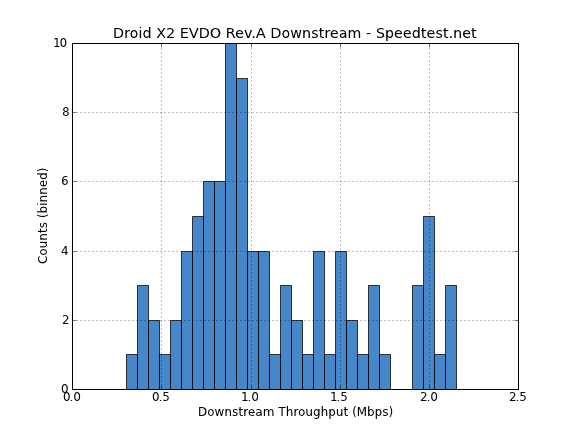
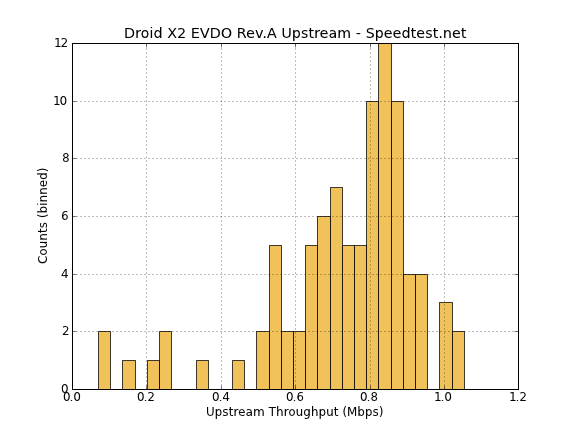

I ran just shy of 100 speedtests on the X2 and created histograms as always. Let me just say that it’s hard coming down off of LTE’s order of magnitude faster performance to EVDO Rev.A, seriously. Downstream performance is between 0.5 and 2 Mbps, about what I’m used to seeing for Verizon’s EVDO Rev.A network. Upstream is centered around an admittedly fast 0.8 Mbps. Latency has a bunch of erroneous results clustered down in the single digit ms response times which are just the speedtest.net application glitching out for some reason.
I neglected to put the X2 through our attenuation test suite, but again the device has receive diversity with cellular antennas at the top and bottom of the handset and should perform just as well as the first device. Likewise I didn’t notice any unwarranted drops in signal while using the handset and holding it. Over in field test (##program followed by 000000), the X2 reported signal usually within 1-2 dBm of the original Droid X.
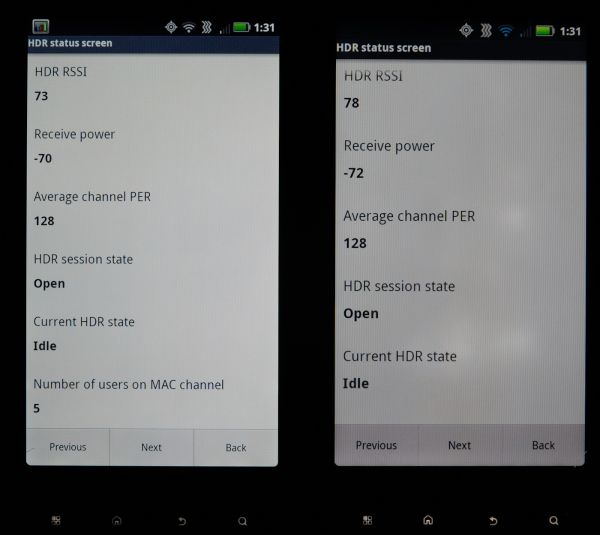 Left: Droid X2, Right: Droid X
Left: Droid X2, Right: Droid X
If you’ve been reading any of our smartphone reviews, you should be able to guess what WLAN and BT chipset is inside the Droid X2. Yes, it’s another smartphone with Broadcom’s BCM4329 combo chip, which means it has 802.11n single stream support on 2.4 GHz.
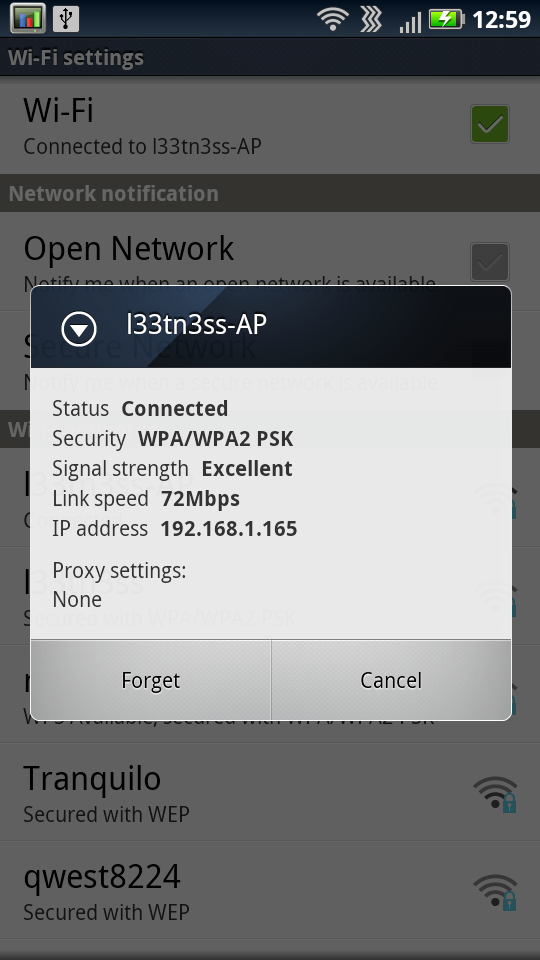
Performance is pretty speedy on our WiFi transfer test which consists of a 100 MB PDF being downloaded from a local server. WiFi range is also virtually unchanged from the Droid X, again I walked around my house with RSSI visible and watched the X and X2 sit within 1-2 dBm of each other, odds are it's the same antenna inside.
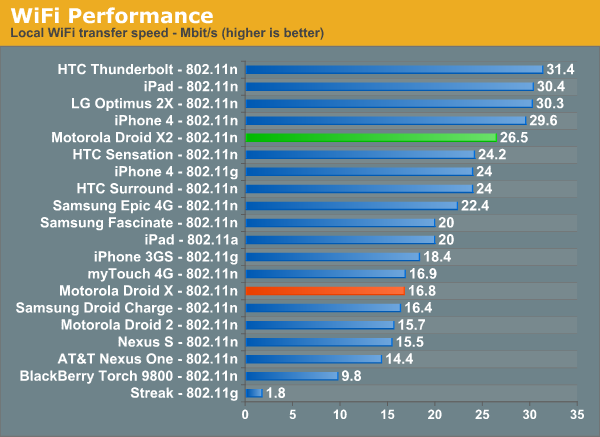
Things have indubitably sped up in part due to the X2's WLAN stack giving the 72 Mbps short guard interval rate instead of 65 Mbps long guard interval 802.11n speeds on the X.










72 Comments
View All Comments
Hrel - Thursday, July 7, 2011 - link
I'd like to see them add an attachable/detachable slide out keyboard. Then they could also add a gamepad for actual hand held gaming. And they'd get to make money selling more accesories. It's a win for everyone! The thing is so thin as it is it can stand to gain some thickness without being an issue AT ALL.snoozemode - Thursday, July 7, 2011 - link
what do you mean, u cant see the grainy pattern in blue color? i see it just as good as in green, download the engadget app and put the icon on the homescreen, tons of black spots in it where the white subpixels have closed. RGBW sucks, period.bjacobson - Thursday, July 7, 2011 - link
all these high powered phones but scrolling up and down with your finger on a webpage is still laggy as hell. ???bplewis24 - Friday, July 8, 2011 - link
They're displaying flash images...what do you expect?JayQ330 - Thursday, September 1, 2011 - link
you have to download a gpu rendering browser, its the reason the iphone & samsung galaxy s2 & even the s are able to scroll & zoom in & out so smooth, when you see checker board effect you know its gpu rendered where as the regular android browsers are constantly resizing & adjusting words & images in realtime. they should take a hint from samsungs browser.NeoteriX - Thursday, July 7, 2011 - link
If I was looking on my HTC Evo 3D, what text would I be searching for in the dmesg output to identify the camera initialization line?Brian Klug - Thursday, July 7, 2011 - link
Things like this:<4>[ 14.364959] __s5k3h1gx_probe
<6>[ 14.365051] s5k3h1gx_vreg_enable camera vreg on
<6>[ 14.365173] sensor_vreg_on camera vreg on
<6>[ 14.365722] sensor_power_enable("gp4", 2850) == 0
<6>[ 14.366180] sensor_power_enable("gp6", 2850) == 0
...
<6>[ 14.463897] s5k3h1gx_probe successed! rc = 0
<6>[ 14.464141] ov8810 s->node 1
<6>[ 14.464324] s5k3h1gx: s5k3h1gx_sensor_probe: switch clk
<6>[ 14.464416] Doing clk switch (s5k3h1gx)
<6>[ 14.484527] [Camera] gpio_request(30, "s5k3h1gx")
Note the part with OV8810 which is an omnivision 8 MP 1/3.2" sensor. Possibly the Sensation uses some parts Samsung, some parts OV.
YoPete525 - Thursday, July 7, 2011 - link
Great review as always, but I still find it ironic how far software optimization has to come on Android in general. I realize the X2 is rendering 26%(?) more pixels, but for every time it appears to process actions more quickly than the X, there is an example of it falling behind, like when pulling up the menu with the hardware button, and loading Basemark from the app drawer. Also, if you were to load up one of the more scrolling-conscientious launchers from the market, like LauncherPro or Go Launcher, the homescreens would scroll essentially at the device's refresh rate without stutter. Same story with Opera Mobile vs. the stock browser.NeoteriX - Thursday, July 7, 2011 - link
As I thought when I first looked at the dsmeg output; looks like it's no dice -- where the sensor ID should be is only "sp3d":<6>[73834.064016] [CAM]sp3d_vreg_enable camera vreg on
<6>[73834.064139] [Camera]Shooter_sp3d_vreg_on
...
<6>[73837.130660] [CAM]sp3d_spi_open_init: 1697
<6>[73837.130691] [CAM]sp3d_vreg_enable camera vreg on
<6>[73837.130691] [Camera]Shooter_sp3d_vreg_on
<6>[73837.132155] [CAM]sp3d: sp3d_sensor_probe: switch clk
<6>[73837.163436] [CAM]sp3d_sensor_setting type:0 config:0
Thoughts?
BTW, for what it's worth, the HTC Evo 4G uses the OV8810 omnivision for its camera:
<6>[690609.827789] [CAM]ov8810_resume
wpwoodjr - Thursday, July 7, 2011 - link
The effective available RAM memory on the DX2 is about 70-80mb less than the DX, you can see this by looking at Settings...Applications...Running Services and adding up the used and free memory. I was all set to buy a DX2 until I saw this. Even in the store I could easily make the Moto launcher close and be forced to redraw with only a few programs open. My DX already runs out of memory, I didn't want more problems. Perhaps this memory is taken up by the graphics card?It would be great if you added some multi-tasking tests to your reviews that would stress memory.